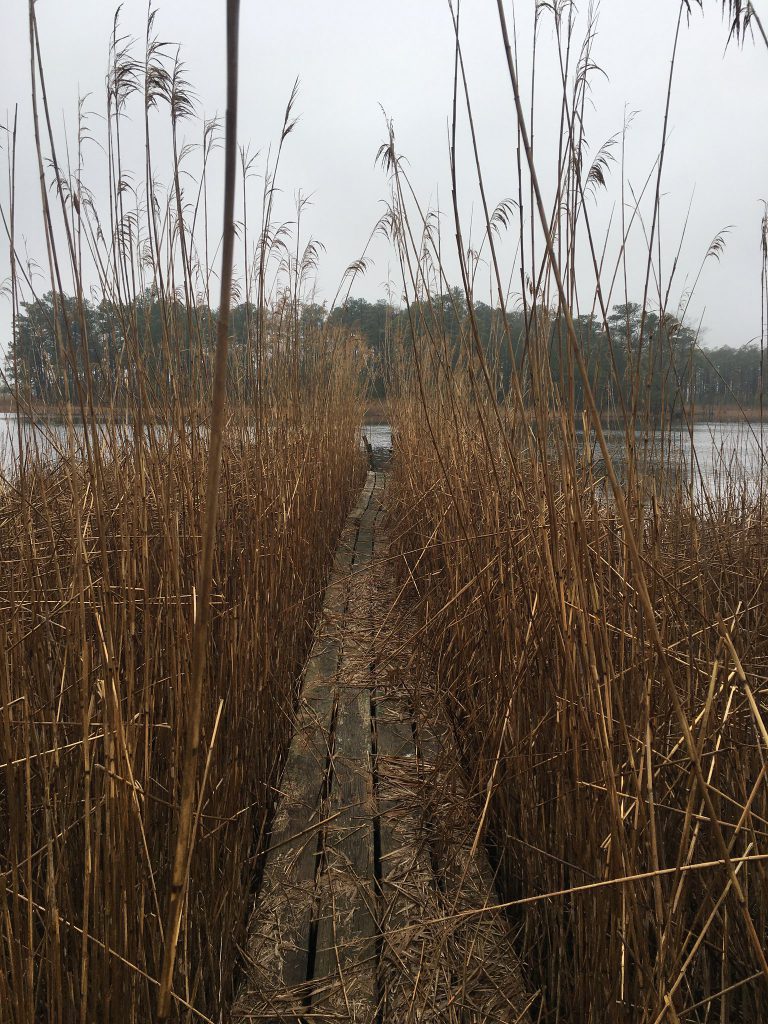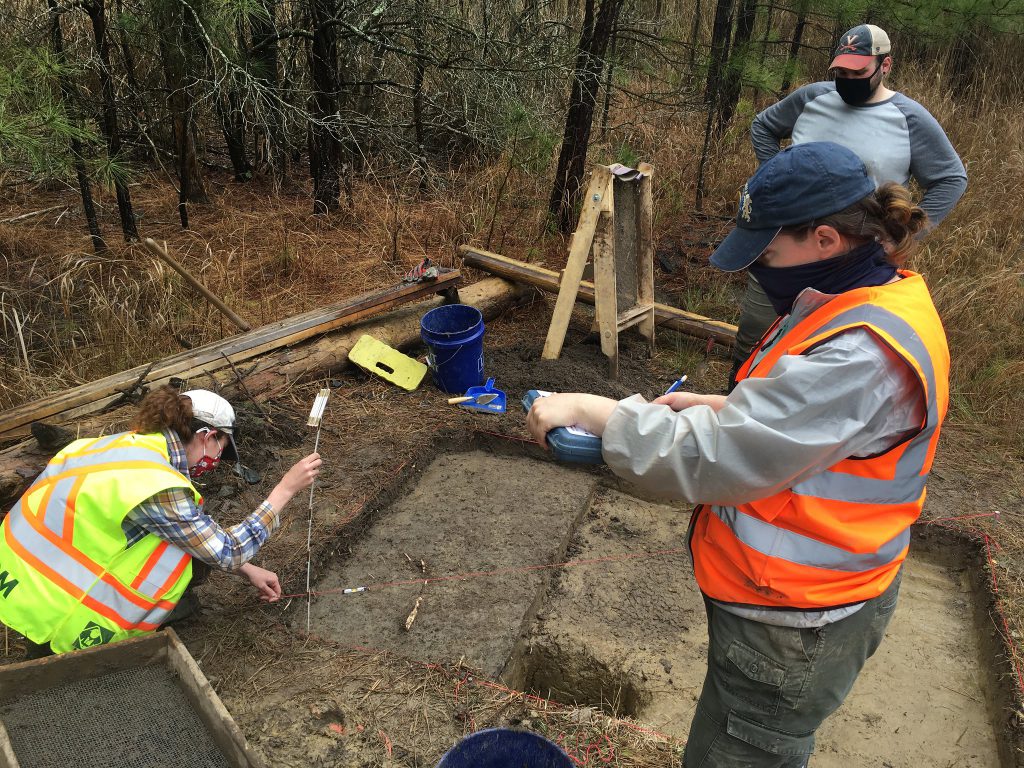Finding ‘Ben’s 10’: Maryland Archaeology Team Races Elements for Major Harriet Tubman Find
As fog burned off the wetlands at the Blackwater National Wildlife Refuge one March morning, Dr. Julie Schablitsky trudged deep into the muck. Water inundated the roads, and phragmites grew alongside. Trees succumbing to rising waters—collectively called “ghost forests”—loomed overhead.
For Schablitsky, Chief Archaeologist at the Maryland Department of Transportation (MDOT) State Highway Administration, the trek through this flooded marshland was worth it.
On this day, a team of archaeologists led by Schablitsky spent the day excavating numerous artifacts from the soggy ground. The team discovered pieces of glass, dishes, nails and other items. The fragments appeared to date to the 19th century, Schablitsky said.
Here, deep in the Blackwater National Wildlife Refuge on Mary-land’s Eastern Shore, Schablitsky’s team had made an important archaeological discovery.
Weeks after that soggy morning, on a sunny and warm day in April, Lieutenant Governor Boyd Rutherford and other state and federal officials joined Schablitsky’s team to announce the discovery of a homesite that once belonged to Ben Ross—the father of famed abolitionist Harriet Tubman.

A view of the river near the discovery site in Blackwater National Wildlife Refuge. Photo by Tim Pratt.
The site, known in the 1800s as “Ben’s 10” after the 10 acres on which Ben Ross lived, was found in a newly acquired portion of the Blackwater refuge. While the site is not open to the public, dignitaries and Ben Ross’s great-great-great-granddaughter attended the event to announce the discovery at the nearby Harriet Tubman Underground Railroad Visitor Center in Dorchester County, Maryland.
“This discovery adds another puzzle piece to the story of Harriet Tubman, the state of Maryland, and our nation,” said Lieutenant Governor Rutherford. “It is important that we continue to uncover parts of our history that we can learn from, especially when they can be lost to time and other forces. I hope that this latest success story can inspire similar efforts and help strengthen our partner-ships in the future.”
Finding the Site
The U.S. Fish & Wildlife Service purchased the 2,600-acre Peter’s Neck property for $6 million with Land and Water Conservation Funds and revenues from the Federal Duck Stamps program, along with assistance from The Conservation Fund. This land was purchased as a critical addition to the Blackwater refuge due to the impact of sea-level rise, providing future marsh migration and out-door recreation opportunities.
Last fall, the U.S. Fish and Wildlife Service reached out to Schablitsky’s team about the possibility of Ross’s former cabin being located within the Blackwater refuge. Researchers got to work immediately. They looked at land deeds, wills, and other historical documents to help narrow the search for the property, which was bequeathed to Ben Ross by Anthony Thompson, the land-owner for whom the enslaved Ross served as a timber inspector. As outlined in Thompson’s will, Ben Ross was to be freed five years after Thompson’s death in 1836. Ben Ross was freed from slavery and received the land in the early 1840s.
Tubman visited her father’s cabin throughout her childhood and teenage years. As a teenager, she worked alongside him as he harvested trees, Schablitsky said.
“This was really the opportunity she had to learn about the wet-lands and the woods and how to survive and navigate through here,” Schablitsky said.
Tubman went on to lead approximately 70 enslaved people to freedom on the so-called “Underground Railroad,” a network of safehouses for enslaved people heading north to freedom, and helped free hundreds more over the course of her life.
Resilience to Preserve the Past
Archaeologists began searching the refuge for “Ben’s 10” in November 2020, screening the mud and dirt for artifacts at approximately 1,000 sites. The team found everything from spent shotgun shell casings to pieces of brick before discovering artifacts at the excavation site.

Archaeologists Kayla Marciniszyn, left, Diannah Bowman, and Brandon Ellis work the site. Photo by Tim Pratt.
“Nothing is too small,” said excavation team member Diannah Bowman. Dozens of artifacts were pulled from the site.
One challenge to the continued exploration of this rich archaeological find is that the site could one day be underwater due to sea level rise and land subsidence.
“The important thing about excavating and trying to find Ben Ross’s site is that we’re very much worried that the rise of sea level is going to continue to impact it,” Schablitsky said. “Not just from the decomposition of the artifacts, but also the deeper you go in the soil, you start to have that water rise up. So, in 10 years, we may not even be able to access the site.”
The good news is that Maryland is doing something about it. MDOT has projects underway across the state to help protect infrastructure and communities from sea level rise and flooding, including one set to begin off the coast of Dorchester County: the Mid-Chesapeake Bay Island Ecosystem Restoration Project.
MDOT is working with the U.S. Army Corps of Engineers on the Mid-Bay project to rebuild heavily eroded James and Barren islands using dredged sediment. The barrier islands have been slowly disappearing, but the ecosystem restoration project will rebuild them and turn them into sprawling natural habitats. Those habitats will help protect Dorchester County’s eroding shorelines and, ultimately, the Ross archaeological site.
This Brings Enlightenment’
Harriet Tubman was born Araminta Ross in March 1822, on the Thompson Farm near Cambridge in Dorchester County. She and her mother were enslaved by the Brodess family and moved away from the farm when she was a toddler. Ben Ross felled and sold timber, which was transported by free Black mariners to Baltimore shipyards and used to build ships. While Harriet Tubman learned to navigate difficult terrain working with her father, interacting with mariners also provided knowledge of waterways on the East Coast, which may have helped her lead people to freedom via the Underground Railroad.
“Discovering the location of patriarch Ben Ross Sr.’s home and artifacts he used has humanized a man responsible for giving us a woman of epic proportions, Harriet Ross Tubman,” said Tina Wyatt, Harriet Tubman’s great-great-great-grandniece and Ben Ross’ great-great-great-great-granddaughter. “This brings enlightenment, revealing how he lived his daily life, making it a real-life connection to and for me. The world benefits also from the study of these artifacts concerning objects used by the enslaved; are they common to this plantation, to his position, or to this region? It gives us so much more to explore, explain, and exhibit.”
The archaeological discovery of Ben Ross’ home site will be highlighted on the historic Thompson Farm where he and his family were enslaved. This new point of interest will be officially added to the Harriet Tubman Underground Railroad Byway, designated an All-American Road by the U.S. Department of Transportation Federal Highway Administration. The byway is a 125-mile scenic drive that includes more than 30 sites related to Tubman’s life and legacy.
“The landscape surrounding our 17-acre park looks much the same today as it did then. This view offers a powerful experience that really allows you to appreciate how well Harriet Tubman knew the terrain and how she used it to help others to freedom,” said Maryland Department of Natural Resources Secretary Haddaway-Riccio. “Preserving and protecting these newly discovered artifacts provides an additional way to experience her heroic story and connection to the land.”
“This remarkable archaeological discovery is another reason that Maryland is ‘The Most Powerful Underground Railroad Storytelling Destination in the World,’” said Maryland Department of Commerce Assistant Secretary Tom Riford. “The newly found artifacts coupled with the historical research being conducted through a partnership between the Office of Tourism, the Maryland State Archives Legacy of Slavery program and other public and private organizations ensures the authentic interpretation of the Under-ground Railroad all across Maryland.”
The partnership between Blackwater National Wildlife Refuge, Harriet Tubman Underground Railroad State Park, and Harriet Tub-man Underground Railroad National Historical Park will continue to focus on future opportunities to conserve the history and habitat of the parcel, as well as explore opportunities for future interpretation that combine natural and cultural history.
The artifacts will be on temporary display at the Harriet Tubman Underground Railroad State Park and Visitor Center, and will be curated permanently at Jefferson Patterson Park & Museum in Southern Maryland.
Even though Schablitsky has been an archaeologist for decades—it’s a field she has been interested in since she was 7 years old—she still gets excited when new artifacts show up during an excavation. That’s especially true after all the research and digging that went on during the Ross excavation.
“I was always confident that if it was here, we’d find it,” she said. “To be able to exactly know where ‘X’ marks the spot in the ground, it’s a great feeling because I think of all the potential that’s going to come out of the ground and all the new information we’re going to learn about not only Ben Ross, but Harriet Tubman and about the space she used as a training ground to bring people to freedom.”
Tim Pratt is Senior Writer and Public Affairs Manager for the Maryland Department of Transportation Office of Public Affairs. Article appears in Vol. 24, No. 4 of the Maryland Natural Resource magazine, fall 2021.




 1-888-373-7888
1-888-373-7888 233733
233733